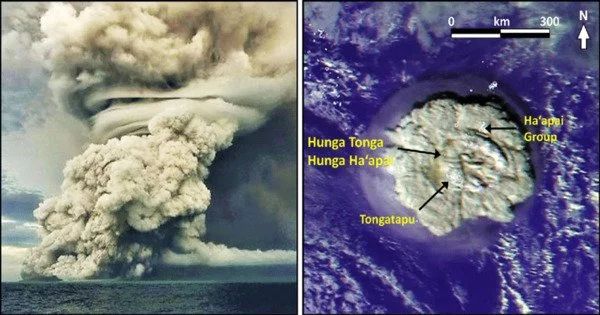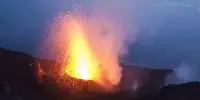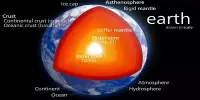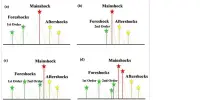The massive eruption of the Hunga submarine volcano in the South Pacific Ocean on January 15, 2022, produced a variety of atmospheric wave types, including booms heard 6,200 miles away in Alaska. It also produced an atmospheric pulse, resulting in an unusual tsunami-like disturbance that arrived on Pacific shores before the actual tsunami.
These are just a few of the findings reported by a team of 76 scientists from 17 countries who studied the eruption’s atmospheric waves, which were the largest seen from a volcano since the 1883 Krakatau eruption. The team’s findings, which were compiled in an unusually short period of time due to widespread scientific interest in the eruption, were published today in the journal Science.
David Fee, director of the Wilson Alaska Technical Center at the University of Alaska Fairbanks Geophysical Institute, is a lead author of the study and one of four center researchers involved in it.
The Hunga eruption, near the island of Tonga, has revealed previously unknown details about the behavior of some atmospheric waves. The data was compiled using a dense network of barometers, infrared sensors, and seismometers in Alaska operated by the Geophysical Institute’s Wilson Alaska Technical Center, Alaska Volcano Observatory, and Alaska Earthquake Center.
Lamb waves are uncommon. We have a very limited number of high-quality observations of them. We can better understand the source and eruption if we understand the Lamb wave. It is related to the tsunami and volcanic plume generation, as well as the higher-frequency infrared and acoustic waves produced by the eruption.
David Fee
“Our hope is that by understanding the atmospheric waves from this eruption, we will be better able to monitor volcanic eruptions and tsunamis,” said Fee, who is also the coordinating scientist at the Geophysical Institute’s portion of the Alaska Volcano Observatory.
“The atmospheric waves were recorded globally across a wide frequency band, and we will better understand acoustic and atmospheric wave generation, propagation, and recording by studying this remarkable dataset,” he said. “This has implications for monitoring nuclear explosions, volcanoes, earthquakes, and other natural phenomena.”
The researchers found particularly interesting the behavior of the eruption’s Lamb wave, a type named for its 1917 discoverer, English mathematician Horace Lamb. The largest atmospheric explosions, such as from volcanic eruptions and nuclear tests, create Lamb waves. They can last from minutes to several hours.
A Lamb wave is a type of guided wave that travels parallel along the surface of a material and extends upward. The wave from the Hunga eruption circled the planet four times in one direction and three times in the opposite direction, just as it did during the Krakatau eruption in 1883.
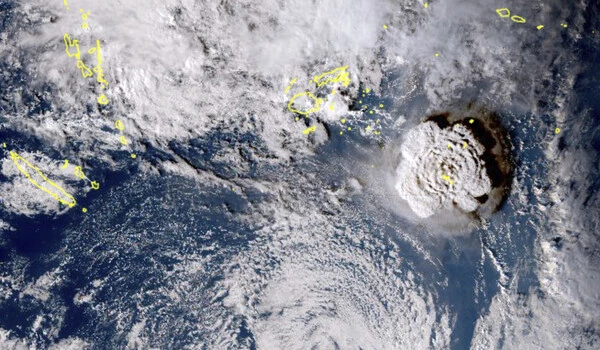
“Lamb waves are uncommon. We have a very limited number of high-quality observations of them” Fee stated. “We can better understand the source and eruption if we understand the Lamb wave. It is related to the tsunami and volcanic plume generation, as well as the higher-frequency infrared and acoustic waves produced by the eruption.”
The Lamb wave consisted of at least two pulses near Hunga, with the first having a seven- to 10-minute pressure increase followed by a second and larger compression and subsequent long pressure decrease.
According to data from ground-based stations, the wave also reached the Earth’s ionosphere, rising at 700 mph to an altitude of about 280 miles. According to the paper, a significant difference between the Lamb wave of the Hunga explosion and the 1883 wave is the amount of data gathered as a result of more than a century of technological advancement and the proliferation of sensors around the world.
Other findings about the eruption’s atmospheric waves included “remarkable” long-range infrasound – sounds too low in frequency to be heard by humans. Infrasound arrived after the Lamb wave, and in some areas, it was followed by audible sounds.
The paper notes that audible sounds traveled about 6,200 miles to Alaska, where they were heard as repeated booms around the state about nine hours after the eruption. “I heard the sounds but didn’t think it was from a volcanic eruption in the South Pacific at the time,” Fee said.
The Alaska reports are the most distantly documented accounts of audible sound. According to the paper, this is due in part to global population growth and advances in societal connectivity. “We’ll be studying these signals for years to figure out how the atmospheric waves were generated and how they spread so well across Earth,” Fee said.
